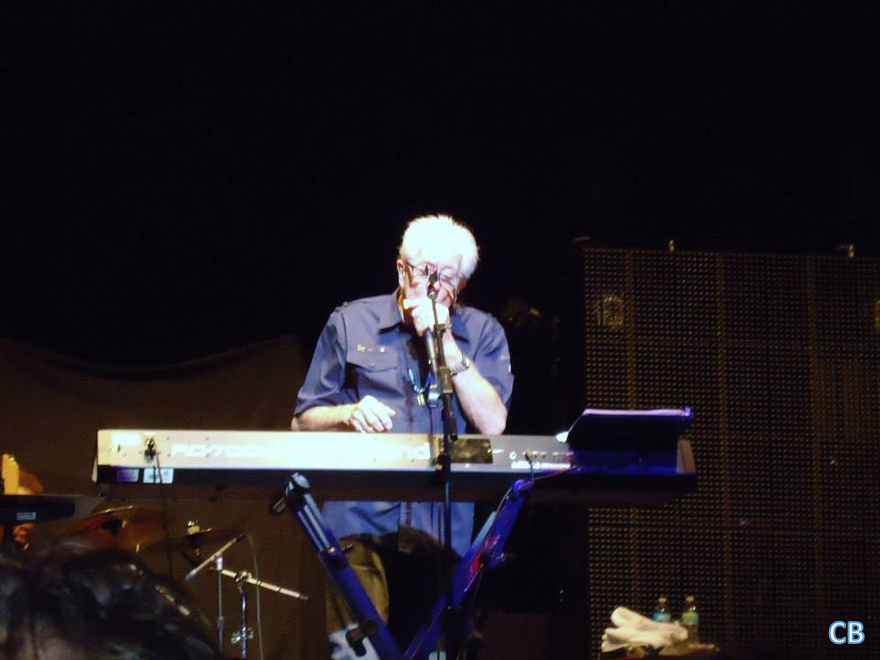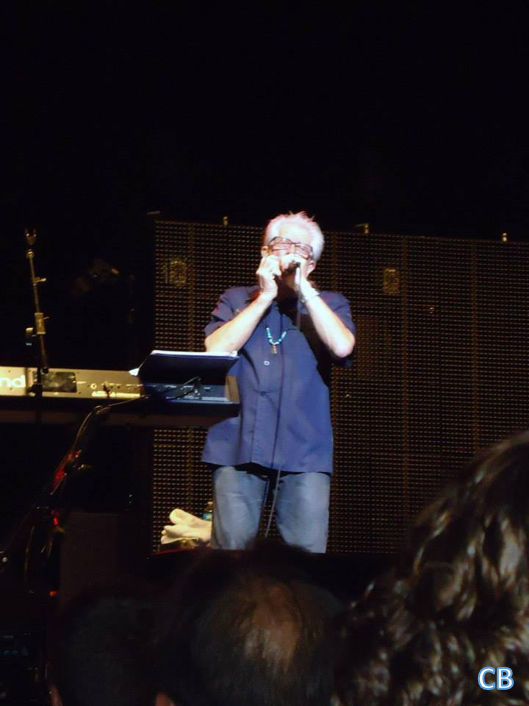John Mayall: The Blues Owes Him A Debt Of Gratitude
August 19, 2011 was a beautiful Summer evening in South Bend, IN. I was still working downtown in banking, as was my wife, but on this particular night, we were not rushing home to go through the typical domestic gyrations folks do when they return home from work. Shortly after 5pm, we met at one of our favorite restaurants downtown, and then afterwards walked a short couple of blocks to South Bend’s Morris Performing Arts Center.
The Morris Performing Arts Center is a grand ornate theater built in 1922 that has presented all types of entertainment, including vaudeville acts, Broadway troupes, The Ziegfeld Follies with George Burns, Gracie Allen, and Fanny Brice, singers such as Elvis Presley, Marvin Gaye, Tony Bennett, Bing Crosby, and Frank Sinatra, the legendary magician Houdini, movie world premieres such as “The Gipper” when Ronald Reagan, Rudy Vallee, and Bob Hope appeared, and all genres of musical stars and acts including Rush, Def Leppard, Hank Williams, REO Speedwagon, The Eagles, ZZ Top, The Eagles, Ted Nugent and the Amboy Dukes, Judas Priest, Eddie Money, Stevie Ray Vaughan, Foghat, B.B. King, and many more. The venue is also home to The South Bend Symphony Orchestra. You get the picture; the setting was again going to offer a top-flight package of entertainment, and on the particular evening in question, George Thorogood and The Destroyers were the headliners, with John Mayall and his band to open the show.
I had long admired John Mayall and his place in music history, particularly, as it related to the blues. But for all my years of devoting countless evenings and hours to seeing my blues heroes in-performance, I had never had the opportunity to witness Mayall in concert. As excited as I was to see Thorogood and his great band (my wife and I, plus our friend, Larry, had second row center seats to the show), I was especially intrigued as to Mayall’s show, especially because he was getting on in years (78 years of age at this performance), and I was curious as to what to expect.
Born in northwest England in the early 1930s, Mayall came to his interest in music honestly, as his father was a jazz music fan, and a guitarist, as well. It is said that in his home during his youth, Mayall was attracted to the music of American musicians, including jazz guitarist Eddie Lang, blues/folk giant Huddie Ledbetter (Leadbelly), boogie woogie pianist Albert Ammons, and blues piano artist Pinetop Smith. Due to his extreme interest in his wide sphere of musical interests, Mayall took it upon himself to learn to play harmonica, guitar, and piano.
A three-year stint in the service in Korea led to Mayall returning back to England, where he enrolled in college studying art. However, during his time in the service, he purchased his first electric guitar, and because of this, once home, he also started playing in a band named the Powerhouse Four in 1956, a band of semi-professionals like himself. Upon graduation from college, Mayall found work as an art designer, and continued his amateur music career. It was in 1962 when Mayall became a member of a group named The Blues Syndicate, a band that attempted to meld jazz and blues. However, in 1963, Mayall decided to move to London at the urging of Alexis Korner, a man who many consider “the father of British blues”, where he made music his full-time vocation. With his band including John McVie (of Fleetwood Mac fame) on bass, Peter Ward on drums, and Bernie Watson on bass, the fist incarnation of The Bluesbreakers was set. Shortly thereafter in 1964, the band had its first recording opportunity, though using Martin Hart on drums, and they laid-down two cuts, though they generated little momentum. It was not long after this recording session that Huge Flint replaced Martin Hart on the drums, and Roger Dean took over guitar chores from Watson. This band lineup then backed John Lee Hooker on tour when he visited Britain in 1964.
In late 1964, the band was offered a chance to record a “live” performance for Decca, and while the recording and a released single again didn’t generate any traction, change on the horizon would signal a new phase for Mayall.
In 1965, Eric Clapton replace Dean as the band’s guitarist. This afforded the band newfound and great attention. But, more change was on the horizon, as Clapton decided to leave for a tour of Greece, with Mayall bringing in Peter Green as the band’s guitarist. Also, McVie was ousted for the band, replaced by the heralded Jack Bruce. However, Clapton did return to the band (as was promised him) after his Greek tour), and McVie also returned.
1966 saw The Bluesbreakers again record for Decca, and over a short three-day span, the seminal album, Blues Breakers With Eric Clapton, was completed. However, in June, 1966, Clapton’s plans to form the rock group Cream, with Bruce and drummer Ginger Baker, leaked out, and Mayall replaced Clapton again with Green. The band managed to record dozens of tracks in the ensuing year, and an album was released in early 1967. However, Green decided to depart the band, taking all of the Bluesbreakers with him, forming Peter Green’s Fleetwood Mac.
Now that the earliest years of John Mayall’s musical career have been outlined, it should be obvious that change has been a constant force in his musical journey, that he always sought to surround himself with the best talent possibly, and that change was a constant force for him. Particularly, as it pertains to the role of guitarist in his various bands. Mayall’s bands have long been seen as the proving grounds for a guitarist to prove his blues muster, and the roster of individuals who have played in Mayall’s bands is staggering in depth and breadth of talent. The names include Clapton, Green, Mick Taylor, Harvey Mandel, Jon Mark, Buddy Whittington, Walter Trout, Coco Montoya, James Quill Smith, Freddy Robinson, among others.
Jumping to the 1970s, Mayall relocated to the U.S., where he spent roughly 15 years recording with local musicians across a number of labels. In 1982, Mayall reunited with McVie, Taylor, and Collen Allen (three band members from the formative 1960s years) for a tour that lasted a couple of years. A “live” recording from this tour did see the light of day, but it took about ten years to be released.
Mayall decided to resurrect the Bluesbreakers name in 1984 when he utilized Trout and Montoya both in the band simultaneously. Mayall toured and recorded an album that was released in 2001 that celebrated his many years in music that featured past Bluesbreakers members and additional musical friends. Mayall also participated in a 2003 fundraiser show with Clapton, Taylor, and Chris Barber. Yet, in 2008, Mayall decided to permanently retire the Bluesbreakers name.
Mayall’s last band consisted of prior Buddy Guy bassist Greg Rzab, and drummer Jay Davenport, who hailed from Chicago’s south side. This group core was assembled in 2008.
Mayall is now 89 years of age, and a post on his web site indicates the following:
“I have decided, due to the risks of the pandemic and my advancing age, that it is time for me to hang up my road shoes. As a result I will be radically reducing my touring schedule and will be limiting my performances to local shows near my home in California, and the occasional concert further afield. My epic road dog days however have come to an end. I want to thank my audience for all the wonderful decades of shows, your infectious enthusiasm for my music and for your support throughout my many musical incarnations. It has been a privilege to have spent my life doing what I love and having you along for the ride with me through all of it. I may not be travelling to your location, but I do want to continue to share my love of the Blues with you. I have a new musical offering coming your way in the form of my album “The Sun is Shining Down,” which will be released by Forty Below Records on January 21st, featuring my long-time rhythm section of Greg Rzab and Jay Davenport as well as some exciting special guests. I’m proud of what we came up with and excited to share it with you. I look forward to seeing those of you who can attend my local shows, and I will miss all of you who cannot, but as always, keep loving the Blues! —John Mayall”
John Mayall’s long devotion to the blues, and the artists who passed through his various band incarnations, are testament to his standing as one of the caucasian blues artists who introduced the blues to a new crop of young individuals who otherwise may have never before considered the blues as a viable source of interest and joy for them. Mayall’s influence is immense, and many blues and rock artists owe a debt of gratitude to him for his belief in them, and for assisting them in establishing their careers.
In 2011, as I watched the 78-year-old Mayall play piano and harmonica at the same time, sing the blues with soaring passion, and lead his astounding band with care and a nurturing spirit, I felt a sense of awe. I was in the company of authentic blues greatness.
I will never forget Mayall in concert, and blues lovers everywhere are indebted to him for being such an impassioned advocate for the blues. My city was so fortunate to have had Mayall ply his trade here for one marvelous evening of blues history.


